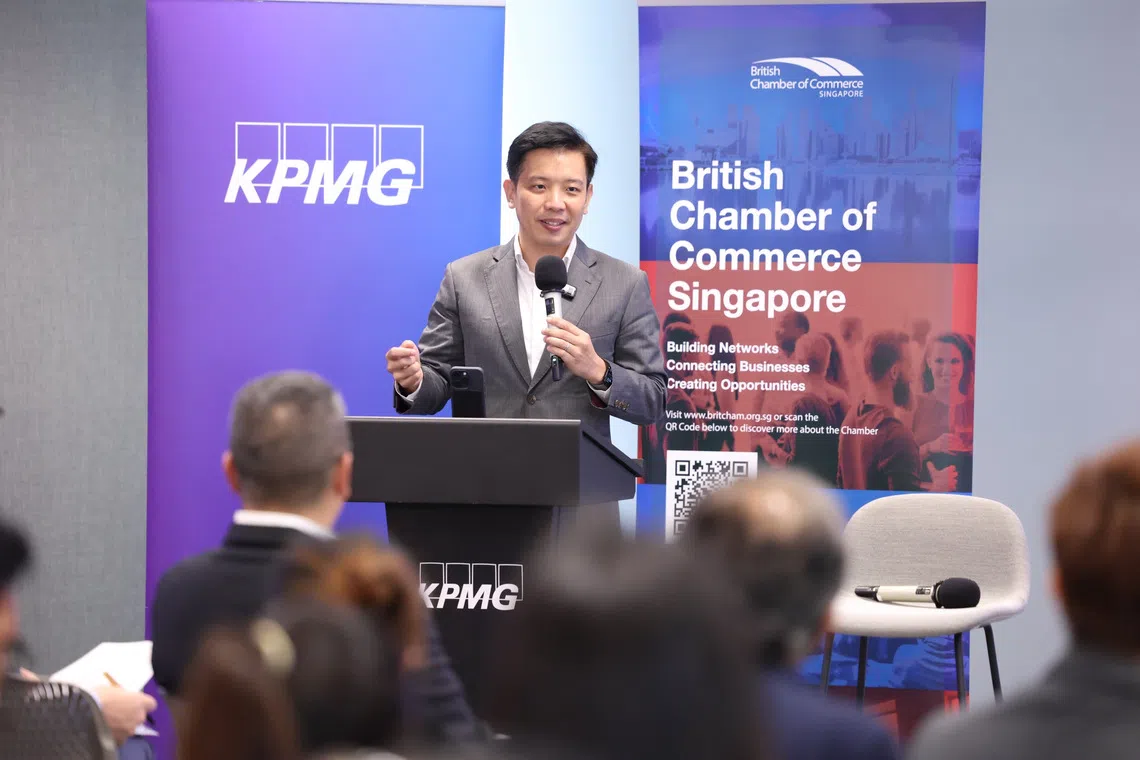Potential exists for trilateral synergies among Singapore, Malaysia and the UK: Minister of State for Trade and Industry Alvin Tan
[SINGAPORE] Small and medium-sized enterprises (SMEs) may lose out on certain perks offered by the Johor-Singapore Special Economic Zone (JS-SEZ) because of their limited size. But, they can still have a piece of the pie by tagging alongside multinational corporations (MNCs) that are making a play for the market.
Yap Wee Kee, partner of the capital markets group at KPMG in Singapore, made this point at a panel discussion organised by the professional services firm and the British Chamber of Commerce (BritCham) Singapore.
The event on Thursday (Sep 18) was graced by Minister of State for Trade and Industry Alvin Tan.
Yap said in his opening remarks: “For SMEs to fully participate and thrive, more can be done to facilitate their involvement; or, the minimum qualifying investment may pose a challenge for some smaller companies.”
He added: “Creating accessible pathways to meet this threshold will be key. Additionally, providing advisory support to help SMEs navigate cross-border complexity and fostering partnerships with the larger players, particularly multinationals, anchoring in the JS-SEZ can open doors for SMEs to participate in their value chain.”
But, for now, many SMEs are taking a wait-and-see approach, noted Yap.
A NEWSLETTER FOR YOU
Friday, 8.30 am
Asean Business
Business insights centering on South-east Asia’s fast-growing economies.
He explained in a separate interview that some of these firms are run by older generations, who see the JS-SEZ as a third iteration of bilateral attempts at economic integration. Having been burnt by previous ventures, such as Iskandar Malaysia that was established in 2006, they find it hard to believe that the JS-SEZ will make a difference, he said.
On the contrary, newer SMEs or those run by second-generation leaders are willing to try, but may be constrained by resources, continued Yap.
“If they are in a business whereby they need to be near their customers, being in the JS-SEZ will not help unless their customers (are also there). And those customers would be the MNCs; so you need to have the big boys (go) in.”
Complementing each other while competing

In his speech, Tan reiterated that the whole point of the JS-SEZ was to tap the complementary strengths of Singapore and Johor.
“To see Johor (and) Singapore as one for investors and potential companies to invest (in) – that’s how we can be competitive. We are competitive because we are complementary,” said the minister of state.
“It allows for Johor and Singapore to better compete for global investments together. That is the value proposition,” he noted, adding that the zone offers the best of what both parties have to offer.

Trilateral synergies
On what this means for British companies, of which there are more than 6,000 in Singapore, Tan highlighted that the United Kingdom is one of the Republic’s key trade and investment partners in Europe.
“We have a robust political relationship, economic relationship and people-to-people relationship, but we also, as governments, have underlined and supported this business-to-business architecture through very advanced ways of ensuring business-to-business confidence,” said Tan.
The Singapore minister of state added that the UK also maintains a strong business presence in Malaysia, which underscores the potential for trilateral synergies.
Noted BritCham’s Kelly: “The chamber remains committed to helping to signpost businesses to the right partners, including the EDB (Singapore Economic Development Board), to support (their) expansion in this part of the world.”
Working out the kinks
The hour-long panel discussion titled “Capital and Connectivity: Shaping Regional Competitiveness through the JS-SEZ” was moderated by BritCham Singapore’s executive director David Kelly.
The panellists were: KPMG’s Yap; Herman Loh, senior vice-president and head of South Asia, Middle East and Oceania at the EDB; Lavanya Venkateswaran, OCBC’s senior Asean economist; Tony Chan, associate principal, planning business leader for South-east Asia at Arup; and Tobias Dietrich, head of moving division at global mobility company Santa Fe Relocation.
Across the board, the speakers pointed to the JS-SEZ’s attractiveness, but brought up persisting gaps and challenges.
OCBC’s Venkateswaran noted that interest from the bank’s clients has grown in the past months, and that the crux of the issue revolves around the ease of doing business.
“In terms of financing, Singapore and Malaysia’s convertibility, the closeness of central banks, the agreements that have been signed so far have all suggested that liquidity is not an issue,” she said. “It’s more having slightly longer-term plans, understanding whether there is faith in institutions and so on.”
And although uncertainty over the transhipment tariffs by the US still weighs on the world, many companies in the region are no longer looking to export there, added Venkateswaran.
“They’re looking to export within South-east Asia, within Asia, to North Asia… and I think that makes a huge difference.”
What: A Singapore-Malaysia collaboration to promote and facilitate investments in 11 economic sectors – manufacturing, logistics, food security, tourism, energy, digital economy, green economy, financial services, business services, education and health.
Where: An area of more than 3,500 square kilometres – roughly four times the size of Singapore – in the southern Malaysian state of Johor that spans six districts: Johor Bahru, Iskandar Puteri, Pasir Gudang, Pontian, Kulai and Kota Tinggi.
When: Signed on Jan 6 at the 11th Malaysia-Singapore Leaders’ Retreat in Putrajaya.
Milestones: 50 projects in five years, 100 projects within 10 years; create 20,000 skilled jobs.
Who pays: Jointly financed by both governments; Malaysia’s Ministry of Economy will establish an infrastructure fund to build required facilities.
Read more stories on the Johor-Singapore SEZ




